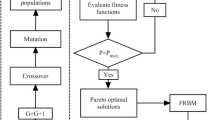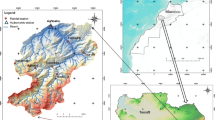Abstract
In this study, an event based rainfall runoff model has been integrated with Single objective Genetic Algorithm (SGA) and Multi-objective Genetic Algorithm (MGA) for optimization of calibration parameters (i.e. saturated hydraulic conductivity (K s ), average capillary suction at the wetting front (S av ), initial water content (θ i ) and saturated water content (θ s )). The integrated model has been applied for Harsul watershed located in India, and Walnut Gulch experimental watershed located in Arizona, USA. Nash-Sutcliffe Efficiency (NSE) and correlation coefficient (r) between observed and simulated runoff have been used to test the performance of runoff models. The SGA and MGA integrated runoff model performance is also compared with the performance of the Hydrologic Engineering Center- Hydrologic Modeling System (HEC_HMS) model. Range of NSE values for study watersheds with integrated MGA, integrated SGA, HEC_HMS and for the event based rainfall runoff models are [−0.61 to 0.79], [−0.5 to 0.74], [−3.37 to 0.82] and [−5.78 to 0.53] respectively. Range of correlation coefficient values for study watersheds with integrated MGA, integrated SGA, HEC_HMS and for the event based rainfall runoff models are [0.18 to 0.95], [−0.55 to 0.90], [−0.18 to 0.97] and [−0.12 to 0.86] respectively. From the results, it is evident that the integrated model is giving the best calibrated parameters as compared to manual calibration methods. Genetic Algorithm (GA) integrated runoff models can be used to simulate the flow parameters of data sparse watersheds.







Similar content being viewed by others
References
Bates B, Ganeshanandam S (1990) Bootstrapping non-linear storm event models. National conference of Hydraulic engineering, Dan Diego, pp 330–335
Bhalla RS, Pelkey NW, Devi Prasad KV (2011) Application of GIS for evaluation and design of watershed guidelines. Water Resour Manag 25:113–140
Duan Q, Sorooshian S, Gupta V (1992) Effective and efficient global optimisation for conceptual rainfall runoff models. Water Resour Res 28:1015–1031
Deb K (2001) Nonlinear goal programming using multi-objective genetic algorithms. J Oper Res Soc 52(3):291–302
Gan T, Biftu G (1996) Automatic calibration of conceptual runoff models. Water Resour Res 32(12):3513–3524
Henrik M (2003) Parameter estimation in distributed hydrological catchment modelling using automatic calibration with multiple objectives. Adv Water Resour 26:205–216
Haghizadeh A, Leila S, Hossein Z (2014) Optimization of the conceptual model of green-ampt using artificial neural network model (ANN) and WMS to estimate infiltration rate of soil (case study: Kakasharaf watershed, Khorram Abad, Iran. J Water Resour Prot 6:473–480
Jain A, Indurthy P (2003) Comparative analysis of event based rainfall runoff modeling techniques-Deterministic, statistical and artificial neural networks. J Hydrol Eng 8(2):93–98
Kamali B, Mousavi SJ (2013) Automatic calibration of conceptual HEC_HMS using multi-objective fuzzy optimal models. Civil Eng Infrastructures J
Keefer TO, Moran MS, Paige GB (2008) Long-term meteorological and soil hydrology database, Walnut Gulch Experimental Watershed, Arizona, United States. Water Resour Res 44(W05S07)
Lafdani KE, Nia MA, Ahmadi A, Jajarmizadehm M, Gosheh GM (2013) Stream flow simulation using SVM, ANFIS and NAM models (A case study). Caspian J Appl Sci Res 2(4):86–93
Mein RG, Larson CL (1973) Modeling infiltration during steady rainfall. Water Resour Res 9(2):384–394
Moussa R, Voltz M, Andrieux P (2002) Effects of spatial organization of agricultural management on the hydrological behaviour of farmed catchment during flood events. Hydrol Process 16(2):393–412
Moussa R, Chahinian N (2009) Comparison of different multi-objective calibration criteria using a conceptual rainfall-runoff model of flood events. Hydrol Earth Syst Sci 13:519–535
Muleta MK, Nicklow JW (2005) Sensitivity and uncertainity analysis coupled with automatic calibration for a distributed watershed model. J Hydrol 306:127–145
Ratha D, Agrawal VP (2014) Structural modeling and analysis of water resources development and management system: a graph theoretic approach. Water Resour Manag 28:2981–2997
Ratha D, Agrawal VP (2015) A digraph permanent approach to evaluation and analysis of integrated watershed management system. J Hydrol 525:188–196
Rajasekaran S, Vijayalakshmipai GA (2007) Neural networks, fuzzy logic and genetic algorithms synthesis and applications. Prentice Hall of India private limited
Reca J, Martinez J (2006) Genetic algorithms for the design of looped irrigation water distribution networks. Water Resour Res 42, W05416
Rao KHVD, Kumar DS (2004) Spatial decision support system for watershed management. Water Resour Manag 18:407–423
Reddy KV (2007) Distributed rainfall runoff modeling of watershed using finite element method, remote sensing and Gepgraphical Information Systems, IIT Bombay, Mumbai (unpublished thesis)
Reddy KVK, Eldho TI, Rao EP, Chitra NR (2008) A distributed kinematic wave-philip infiltration watershed model using FEM, GIS and remotely sensed data. Water Resour Manag 22:737–755
Reddy KV, Eldho TI, Rao EP, Kulkarni AT (2011) FEM-GIS based channel network model for runoff simulation in agricultural watersheds using remotely sensed data. Int J River Basin Manag 9:17–30
Rosenbrock H (1960) An automatic method for fitting the greatest or least value of a function. Comput J 3:175–184
Sahoo D, Smith PK, Ines AVM (2010) Autocalibration of HSPF for simulation of streamflow using a genetic algorithm. Am Soc Agric Biol Eng 53:75–86
Seibert J (2000) Multi-criteria calibration of a conceptual runoff model using genetic algorithm. Hydrol Earth Syst Sci 4:215–224
Srinivas N, Deb K (1994) Multiobjective optimization using nondominated sorting in genetic algorithms. Evol Comput 2(3):221–248
Vrugt, J. et al., 2003. Effective and efficient algorithm for multiobjective optimization of hydrologic models. Water Resour Res 39(5)
Wang L, Meng W, Guo H, Zhang Z, Liu Y, Fan Y (2006) An interval fuzzy multiobjective watershed management model for the lake Qionghai watershed, China. Water Resour Manag 20:701
Xuesong Z, Srinivasan R, David B (2009) Calibration and uncertainty analysis of the SWAT model using Genetic Algorithms and Bayesian Model. Averaging J Hydrol 374:307–317
Yang L, Fan S (2010) Sensitivity analysis and automatic calibration of a rainfall-runoff model using multi-objectives. Ecol Inform 5:304–310
Yapo P, Gupta H, Sorooshian S (1998) Multi-objective global optimization for hydrologic models. J Hydrol 204:83–97
Zhang X, Srinivasan R, Van Liew M (2008) Multi-site calibration of the SWAT model for hydrologic modelling. Am Soc Agric Biol Eng 51:2039–2049
Zarriello P (1998) Comparison of nine uncalibrated runoff models to observed flows in two small urban watersheds. First federal interagency hydrologic modeling conference, Las Vegas, NV, USA,7-163-7-170
Acknowledgments
Our sincere thanks to Mr. Guy Honore, Project coordinator, Indo German Bilateral Project-Watershed Management, for providing the hydrological data of the Harsul watershed. Our sincere thanks to Mr. Jeffry J. Stone, Hydrologist, USDA-ARS Southwest Watershed Research Center, for giving valuable suggestions in downloading the hydro-meteorological database of the Walnut Gulch watershed from the online data access website of the USDA-ARS Southwest Watershed Research Center. We also thank Prof. Kalyanmoy Deb, IIT Kanpur for providing the GA codes through web link: http://www.iitk.ac.in /kangal/index.shtml. The authors also thank the associate editor of this journal and three anonymous reviewers for their valuable comments which improved the manuscript significantly.
Author information
Authors and Affiliations
Corresponding author
Rights and permissions
About this article
Cite this article
Reshma, T., Reddy, K.V., Pratap, D. et al. Optimization of Calibration Parameters for an Event Based Watershed Model Using Genetic Algorithm. Water Resour Manage 29, 4589–4606 (2015). https://doi.org/10.1007/s11269-015-1077-9
Received:
Accepted:
Published:
Issue Date:
DOI: https://doi.org/10.1007/s11269-015-1077-9




